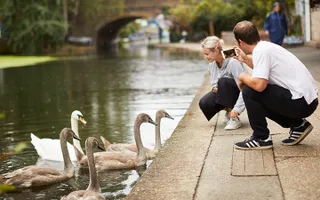Himalayan Balsam is an imposing weed which is negatively impacting vital canalside habitats and outcompeting native species.
Himalayn balsam facts
Scientific name: Impatiens glandulifera
Family: Balsaminaceae
Native to: The Himalayas
Type: Annual
Which species eat it? Sheep and cattle may graze on it, but it's unusual and doesn't cause enough impact to stop the weed from spreading
Location: On land near canal banks and in damp woodland
Himalayan balsam in Britain
Himalayan balsam was introduced to the UK in the 1800s as an attractive ornamental plant for gardens, but quickly escaped and established itself in the wild.
With no natural predators, it has been able to grow freely, colonising in damp ground and causing problems for native flora and fauna.
It is now listed under Schedule 9 of the Wildlife and Countryside Act 1981, meaning it is illegal to cause it to grow in the wild.
Why is Himalayan balsam a problem for canals and native wildlife?
Himalayan balsam doesn't need much light and will grow in a wide range of habitats, but is naturally drawn to damp ground. In the summer it tends to shade out native plants, and even when it dies back in autumn its destructive legacy lives on, leaving waterway banks bare and vulnerable to erosion.
A lack of native plants mean that many insects, including dragonflies and bees, are without suitable spaces to forage.
Species like coots and moorhens rely on rich, green banks to nest and feed, whilst the endangered water vole uses soft canal banks as habitat.
The seed pods of Himalayan balsam explode open when they become ripe and can shoot seeds up to seven metres away. With each plant able to produce around 800 seeds, it quickly dominates its surrounding areas.
What does Himalayan balsam look like?
Between June and August, Himalayan balsam produces attractive pink-purple flowers which have two distinctive oval-shaped petals.
Its stems are green with a red piping effect, which becomes more prominent nearer the flower and also makes its way into the elongated leaves. The leaves have serrated edges and can grow to about 25cm in length.
Himalayan balsam is terrestrial (meaning it grows on land) and can reach up to two metres in height.
How do you remove Himalayan balsam?
Getting rid of Himalayan balsam can be a relatively straightforward process. Unlike giant hogweed, it isn't harmful to humans, so it's able to be removed by hand or machinery.
The main issue is its location. The plant must be cut below its lowest node to prevent regrowth later in the season, but as it tends to grow amongst brambles or on damp, inaccessible waterway banks, it can be challenging to reach.
Himalayan balsam can also be controlled by herbicide, but this must be at the right time of year. It needs to be in the spring before flowering, but late enough to ensure that germinating seedlings are present enough to be covered by the spray.
As part of our award-winning Invasive Species Eradication Project, we trialled an eco-friendly dredging, hessian matting and hydroseeding process on Himalayan balsam found at the Penarth Feeder. This was a first-of-its-kind technique, which successfully reduced the need for further treatment by 90%.
How to report invasive species
If you see an invasive, non-native plant species on one of our canals or rivers, please contact us online or call us on 0303 040 4040 and we'll check if it is already included in our treatment schedule.
Other invasive species on our canals
Last Edited: 30 June 2025













